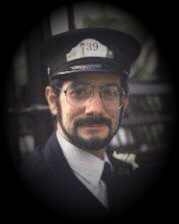by
John LaCosta
| Track Updates for June 21, 1998 |
|---|
Both students in the training class have completed their conductor's written
exam with Greg Thompson in the process of getting his student conductor runs,
while Charlie Plantholt having requalified as a conductor. Cath La Costa
started the training class with a class on how to interact with the museum
visitors so that they will enjoy their visit and learn about streetcars in the
process. Just to let the students see what type of talks are given to the
visitors, she came out and pulled both Ed Amrhein and I into the class.
We
The museum first trains volunteers to run the hand brake cars, and later
trains them to run the air brake cars. This is reverse of what most museums
do, but since we have a large collections of hand brake cars, this allows us
to have most cars available for our visitors with staff we have.
Ed, Rick Obbink, and I spent most of the morning completing the brake work on
the PCC. We also checked the oil in the air compressor. The air is used to
stop the car from moving only when the car is moving less than 8 MPH and to
keep it from moving once it is stopped. The air is also used to open and close
the doors, run the windshield wipers and move the air dampers used to cool the
accelerator drum. While it was on the pit, we also inspected and cleaned the
traction motors. Rick and I also check the batteries and added a little
distilled water.
The PCC uses batteries for similar reasons that your car has
a battery. The battery provides low voltage, 32 VDC, that is used to control
the relays, contactors, and fare box. If the batteries go dead the PCC can not
be run. Since it's the only car in our collection that uses 32VDC, we have to
cheat a little if the batteries go dead, but this seldom happens.
I had to leave around lunch, but Ed and Rick finished greasing all the truck
fittings and took the car out for one trip. When I got back they said that
they were happy with the car but wanted to see what I thought. Since I had not
checked the current reading in a while I attached the amp meter and with Greg
and Paul Ritterhoff, we took a single trip with the car. The car stopped very
well and transferred from Dynamic brakes to air brakes just like it should.
The current readings we good as well. Just to give you an idea of the power
used in starting the car, it uses 600 VDC at 500 amps. This is about equal to
about 10 homes worth of power.
Rick and Ed then showed me the progress they have made on the Baltimore crane.
The have removed about half of the old interior paint from the cab and primed
about a quarter of it. During the paint removal, two colors were found, with
the original gray and the later red. Rick has also started to accumulate the
wood needed to replace the missing deck timbers and the wood on the boom. Rick
also has started to get the fittings needed to put the light circuit back on
the boom.
After a slight break Rick and I put the convertible car, 264, on the pit to
adjust the brakes. While 1164 is out of service this is our tow car for the
line car. We noticed a few weeks ago that the brakes were just a little out of
adjustment. While we adjusted the brakes we also tightened up two brake shoes
that were loose. 264 passed the inspection ride and we called it a day.
Dan Lawrence was Dispatcher with John Diefenbach and Rick Williams as crew and
Greg as the student conductor. The turn out was better than I expected given
the warm temperatures.
Sunday was Father's Day and Dan was Dispatcher, with David Baynes, Jim
Robertson, and Denis Falter as crew. The bad news was the light turn out. It
was a quiet day, everything worked as it should.
Next weekend David Crow will be up and we should start replacing insulators at
28th Street loop. We might also get some more trees cut back from the second
track.
John
 O
n Saturday both students continued the training class while the shop crew
continued working on the PCC.
O
n Saturday both students continued the training class while the shop crew
continued working on the PCC.
were asked to each give a typical speech. While Ed and I did not meet the
revenue uniform standard, unless dirty shop cloths are OK, Rick Williams, Ed
and I gave the students a number of ways to interact with the visitors. After
Cath got done, they went out on the cars with Rick Williams to get more
practice. Just to add more fun to the training, Bernie Sachs came down to get
qualified on the Peter Witt with Ed Amrhein as instructor.
| Previous Track News | Return to Streetcar Page | Comments for The Streetcar Man | Next Track News |
All Rights Reserved